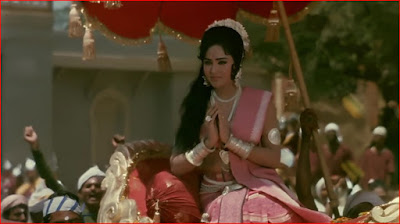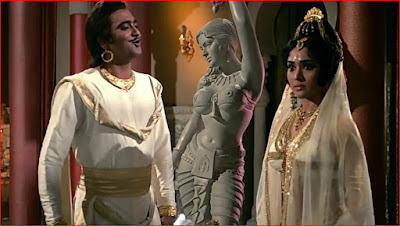Amrapali is moving up in the world. She's appointed the state courtesan, which apparently amounts to the entertainer-in-chief of the republic, after winning a dance-off with a rival whose misperformance of a traditional dance she publicly criticizes. She gets a statue made of herself by a soldier-sculptor who's been crushing on her the whole picture, and when she commissions a statue of her new soldier boyfriend, the sculptor recognizes him as the evil emperor and sculpts him as such. Realizing now how she's been tricked, Amrapali slices the statue in half and repudiates Ajaat Shatru, but refuses to denounce him. That gets her in trouble when the Vaishali authorities announce that they've captured the enemy leader in their midst. It's actually a lookalike the Magadha spies have provided in case of an emergency, but poor Amrapali doesn't know that. As far as she knows, the man she loved is dead, and she's in prison for treason.
Ajaat Shatru had already tarried too long in Vaishali and didn't get to say goodbye to his beloved dying mother, so he's already in a funk when he learns of Amrapali's arrest. That drives him berserk, and at this point Amrapali diverges from the path a western counterpart would have taken. In short, the Magadha monarch brings a mighty host down on Vaishali and utterly destroys it, sparing Amrapali but slaughtering virtually everyone else. He doesn't really comprehend why his beloved isn't happy to be liberated, and at this point you might expect the story to go fully tragic, western style, with Amrapali killing the king and then maybe herself. Again, no. Instead, Amrapali ditches Ajaat Shatru and heads into the forest, where mass chanting indicates that the Buddha is preaching. He's filmed in something like the old Jesus style, visible only from a distance. The noise of the chanting allows Ajaat Shatru to track Amrapali down, but when he hears the typical Buddhist message -- desire leads to fear, which leads to suffering -- he breaks his sword in a gesture of apparent renunciation. And that's it. The resolution isn't the couple living happily ever after, because Buddhism doesn't believe in that the way we do, nor the couple killing each other, for what would that prove? The only hope for either person in the tragedy, as for everyone according to Buddhism, lies in renunciation. The ending is a hopeful note, presumably, for its native audience -- though Buddhism has always been a bigger thing further east than in its native country -- while for many a westerner, Amrapali simply skids to a halt.
While Sunil Dutt was a legendary star in his own right, Amrapali is pretty much a one-woman show -- or a two-woman show if you give credit where due to the Marni Nixon of India, Lata Mangeshkar, who does Vyjayanthimala's singing. Surprisingly, Amrapali is the only character who gets to sing in the picture, and the film actually makes a fairly subtle transition to musical mode. The first "number" of any sort is the big victory celebration, which features a lot of festive dancing until the effigy collapses. Later comes the big dance-off for the Courtesanship, highlighting the star's putative versatility as a dancer, which I as an outsider to traditional Indian dance am not qualified to judge. Finally we get Amrapali expressing her moods privately in songs that are not public performances, but rather just the sort of numbers we expect in Hollywood musicals. These intrusions may make the film more campy than it really is in some eyes, but their main effect is to make the title character, appropriately enough, the absolute center of the picture. She's far from the only attraction, however, Dutt does a good job portraying the wild swings of Ajaat Shatru's personality, and the film's production design is mostly more impressive than you might expect from a 1960s India film. The big exception to that is the work of the film's armorers. While the battles scenes have the numbers (and elephants) to impress, and the director and editor Pran Mehra do a fine job reducing the final battle to an impressionistic montage, the armor and weapons often look suspect, and Ajaat Shatru breaks his sword far too easily at the end. Overall, taking cultural differences into account, Amrapali is an entertaining example of what the world's largest film industry was capable of fifty years go.








No comments:
Post a Comment